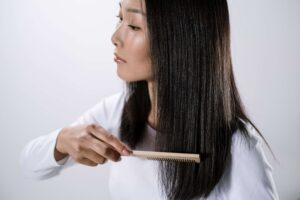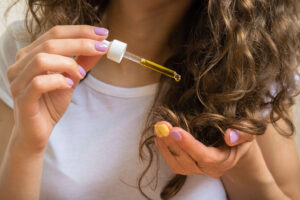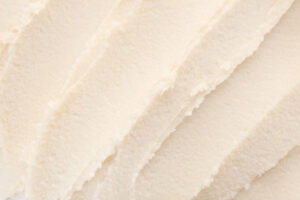
Whether you’re a hair care veteran or just beginning to explore the world of hairstyling, you’ve undoubtedly heard about the wonders of deep conditioning. The science behind it is enchanting, revealing it to be more than just an indulgence at your salon. It’s a pivotal, science-backed step to achieving the luscious, healthy locks you dream of. Ready to delve deeper into the science behind deep conditioning and how it can transform your hair-care ritual? Let’s get started!
“The best thing you can do for your hair is to give it the love it deserves, and deep conditioning is a love language your hair understands.”
What to Expect from This Article
- The importance and benefits of deep conditioning.
- The science behind how it works.
- Expert tips and tricks to obtain the best results.
- How to select the right products for your specific hair type.
- Guidelines to maintain healthy and shiny hair.
Consider this a comprehensive guide to deep conditioning – a journey where science meets beauty, resulting in a stunning and healthy mane that commands attention. So, sit back, relax, and let’s embark on this enlightening journey together.
What is deep conditioning and how does it work?
Deep conditioning is a hair treatment that involves applying a highly moisturizing and nourishing product to the hair. It is designed to penetrate the hair shaft and provide intense hydration and nutrients to the hair strands. Deep conditioning helps to restore and strengthen the hair, making it healthier, softer, and more manageable. It is particularly beneficial for dry, damaged, or chemically treated hair.

Deep conditioning works by using a combination of ingredients that have specific properties to improve the condition of the hair. These ingredients often include moisturizers like oils and butters, proteins, vitamins, and other beneficial compounds. When applied to the hair, these ingredients penetrate the hair cuticle, which is the outer protective layer of the hair shaft. They then work to repair and nourish the hair from within, replenishing moisture, repairing damage, and improving the overall health of the hair.
The process of deep conditioning typically involves applying the product to clean, damp hair and leaving it on for a specific period of time, usually around 20-30 minutes. This allows the product to deeply penetrate the hair shaft and provide maximum benefits. Some deep conditioning treatments may require the use of heat, such as a heated cap or steamer, to enhance the absorption of the product into the hair. After the designated time, the product is rinsed out thoroughly, leaving the hair feeling rejuvenated and revitalized.
Deep conditioning can be done on a regular basis, depending on the individual’s hair needs. For severely damaged or dry hair, it may be beneficial to deep condition once a week or every other week. For relatively healthy hair, deep conditioning once a month or as needed may be sufficient. It is important to choose a deep conditioning product that is suitable for your hair type and specific concerns, as different products may have different formulations and benefits.
In summary, deep conditioning is a hair treatment that provides intense hydration and nourishment to the hair. It works by using specially formulated products that penetrate the hair shaft, repairing damage, replenishing moisture, and improving the overall health and appearance of the hair. Regular deep conditioning can help maintain healthy, soft, and manageable hair.
Understanding the Science Behind Deep Conditioning
If you’ve ever wondered why deep conditioning is often recommended by hair experts, the answer lies in a little bit of science. When you subject your hair to frequent styling routines or environmental stress, the outer layer of your hair, known as the cuticle, may experience wear and tear. Deep conditioning works to restore the shine and strength by infusing the hair strands with vital nutrients and moisture.
Choosing the Right Deep Conditioner
Not all deep conditioners are created equal. Certain ingredients can be more effective than others depending on your hair type and its specific needs. Look out for these nourishing ingredients when selecting your deep conditioner:
- Proteins: If your hair is damaged or chemically treated, a protein-based conditioner can help rebuild your hair’s structure and reinforcement.
- Emollients: Ingredients such as shea butter, olive oil, and argan oil can smooth and soften the hair, making it easier to manage.
- Humectants: These ingredients draw water into the hair, boosting its moisture levels. Glycerin, aloe vera, and honey are common humectants.
- Vitamins: Vitamins A, B, C, and E are regularly included in deep conditioners due to their nourishing and strengthening properties.
Our recommendations
- A rich, deep repairing treatment mask for damaged, over-processed hair of all textures.
This incredible product is designed to disband your tangles and invigorate your scalp with the cooling properties of exotic baobab and an eclectic fusion of mint oils.
For Dry Damaged Hair and Growth - Deep Conditioning Hair Mask with Coconut Oil, Green Tea, Avocado, & Castor Oil
Revive even the driest, most over processed hair. Our exclusive Green Coco formula guarantees salon-fresh shine and bounce after just one use. Say goodbye to lifeless strands and hello to lustrous, envy-worthy hair.
Optimizing Your Deep Conditioning Routine
While deep conditioning is beneficial, it’s only a part of the equation. For the best results, follow these tips:
- Timing: Leaving the product in your hair for at least 15 minutes allows for better absorption.
- Heat: Warmth can help open up the cuticles, enabling the conditioner to penetrate deeper into the hair shaft. Consider using a heat cap or wrap your hair in a towel soaked in warm water.
- Frequency: Typically, deep conditioning once a week is enough, but if your hair is particularly dry or damaged, you might want to do it more frequently.
- Proper rinsing: To retain the benefits of your deep conditioning, rinse with cool water. This closes the cuticle, locking in the nourishment and moisture.
Remember: everyone’s hair is unique, so pay attention to your hair’s specific needs and adjust your routine accordingly. Deep conditioning is a practice of love and patience towards your hair, but trust us, the results are worth it!
The Benefits of Deep Conditioning for Hair Health
Deep conditioning serves a wide range of benefits that all contribute significantly to your hair’s health. At the heart of healthy hair lies moisture and nourishment, both of which deep conditioners generously provide. Let’s delve into the many ways deep conditioning boosts the health of your hair.
Deep Conditioning Replenishes Moisture
Our hair loses moisture every day due to exposure to the environment, heat tools, and chemical treatments. When your hair is dehydrated, it becomes dry, dull, and prone to breakage. Fortunately, by infusing moisture directly into the hair shaft, deep conditioning keeps your locks hydrated, promoting overall hair health and gloss.
Promotes Hair Elasticity
Did you know that the more elastic your hair is, the more resilient it is to damage? Hair elasticity is a key determinant of hair health. It’s the ability of your hair strands to stretch without breaking and then return to their normal shape. Deep conditioners strengthen hair elasticity, making your hair less prone to breakage and split ends.
Restores Essential Nutrients
Deep conditioners are packed with a rich array of nourishing ingredients that replenish your hair’s essential nutrients. These powerhouse conditioners work by penetrating the hair shaft to deliver vitamins, fatty acids, and proteins that your hair needs to stay in top shape. Less damage, more shine!
Increases Manageability
Tired of your hair being hard to brush, style, or manage in general? A deep conditioning treatment can be your hair’s best friend. By providing your hair with moisture and necessary nutrients, you’ll find it becomes much easier to detangle and style, reducing the chances of hair breakage and loss.
Promotes Natural Shine
Finally, let’s not forget about the aesthetic appeal! Deep hair conditioning can give your hair the boost it needs to look its very best. Dull hair becomes a thing of the past as conditioning treatments work to smooth the hair cuticle and promote natural shine. Say goodbye to dull, lifeless hair and say hello to vibrant, shiny locks!
By now, you should have a pretty clear idea of how much of a game-changer deep conditioning can be for your hair. Not only does it make your hair look great, but it contributes significantly to the health and longevity of your hair in the long run. So go ahead, pick the right deep conditioner, optimize your routine, and let your hair flourish in its best health!
How Often Should You Deep Condition?
Establishing a deep conditioning routine that works for your unique hair type and condition is critical. While it might be tempting to deep condition your hair daily to reap the numerous benefits, it’s important to consider your hair’s norms and needs. Overdoing it can be just as damaging as not doing it at all. So, how often should you deep condition your hair?
Generally, it’s recommended to deep condition 1-2 times per week. However, the frequency can vary widely based on your hair type, hair condition, and lifestyle.
The Guide to Deep Conditioning Frequency
| Hair Type | Suggested Deep Conditioning Frequency |
|---|---|
| Normal Hair | Once a week |
| Dry or Damaged Hair | Twice a week |
| Chemically Treated Hair | After Every Wash |
| Oily Hair | Every other week |
Just remember, this is a starting point. What’s most important is to listen to your hair and adjust as necessary. If it feels overly soft and lacks volume, it could be a sign you’re over-conditioning it. Conversely, if your hair continues to feel dry and brittle, you may need to up your deep conditioning game.
Factors Influencing Deep Conditioning Frequency
Beyond your hair type, other factors can influence how often you should deep condition. For example, environmental conditions like wind and sun exposure, use of heated styling tools, and frequency of hair washing can all affect your hair’s moisture levels and thus the need for deep conditioning.
Consider these factors and adjust your deep conditioning routine accordingly. Always remember, patience and consistency will reap the best results when it comes to hair health.
Deep Conditioning vs Regular Conditioning: What’s the Difference?
You might be wondering if there’s a significant difference between deep conditioning and regular conditioning. Is deep conditioning merely an elaborated form of regular conditioning? Let’s unravel this mystery.
Intensity of Treatment
One major distinguishing factor is the intensity of treatment. Regular conditioners work on the surface level. They are great for making your hair smooth and shiny by sealing the hair cuticles. Whereas, deep conditioners saturate deeper into the hair shaft and provide intense, penetrating nourishment. The idea is to deeply feed your hair with all the good stuff it might be missing out on.
Ingredients and Formulation
The second difference lies in the ingredients and formulation. Commonly, deep conditioners are packed with higher concentrations of restorative ingredients, like proteins, oils, and naturally derived extracts. This contrasts with regular conditioners, which may contain fewer of these enriching properties.
Usage Time
Then there’s usage time. Regular conditioners usually get washed out after a couple of minutes. Deep conditioners, on the other hand, need to stay on for an extended period, often between 20 to 30 minutes. This allows the product to thoroughly penetrate the hair strands and deliver maximum benefits.
Frequency of Use
The frequency of use also varies. Regular conditioners are used each time you wash your hair. Deep conditioners are generally used less frequently – about once a week, or according to your specific hair needs.
Both regular and deep conditioners offer their unique benefits. So, it’s not about choosing one over the other. It is about incorporating both into your hair care routine judiciously. Regular conditioning for surface-level smoothness coupled with deep conditioning treatments for profound nourishment – it’s the perfect formula to maintain the health and radiance of your hair.
Understanding the pH Balance in Deep Conditioning
On your journey to superior hair health, understanding the role of pH balance in deep conditioning is a crucial piece of the puzzle. You might be wondering – what does pH balance have to do with your hair? Let’s dive in.
The term ‘pH’ stands for ‘potential Hydrogen’. It measures the acidity or alkalinity of a water-soluble substance (like our hair and scalp) on a scale from 0 (most acidic) to 14 (most alkaline) with 7 being neutral. Hair has a natural pH level of 4.5 to 5.5, placing it on the acidic side of the scale.
Maintaining this natural acidity helps the cuticle layer of our hair – the outermost protective layer – to stay tightly closed. When closed, the cuticle can effectively lock in essential nutrients and moisture necessary for luscious and healthy hair. A pH imbalance, however, can cause the cuticle to open, leading to a host of potential hair issues such as dryness, frizziness, breakage, and dullness.
Maintaining Balanced pH: Why It’s Important
It’s all about balance when it comes to hair health. Using a deep conditioner that’s too alkaline can raise the cuticle layer, increasing the risk of damage. Conversely, a substance that is too acidic could lead to hair feeling hard and brittle.
So, how can you ensure a balanced pH? Aim for deep conditioning products with a pH range close to your hair’s natural levels (4.5 to 5.5). These products will help to keep your hair cuticles closed, preserve moisture, and maintain overall hair health.
Your Guide to Choosing pH-Balanced Deep Conditioners
Look for deep conditioners that specifically mention their pH level on the packaging or in their product descriptions. If not, don’t hesitate to reach out to the brand for more details. Conduct a patch test to see how your hair responds to the product before going all out.
Remember, everyone’s hair is unique. Be patient and observe how your hair reacts to different products and pH levels. Listen to your hair and customize your deep conditioning routine accordingly.
Understanding pH in deep conditioning is indeed essential, as it can significantly impact the health of your hair. Use this knowledge to your advantage, stay consistent, and you’re one step closer to achieving that vibrant and healthy hair you’ve always wanted.
The Role of Heat in Deep Conditioning
When it comes to deep conditioning, heat plays a significant role. It can significantly enhance the penetration of conditioning ingredients into hair shafts, leading to better nourishment and repair. But how exactly does it work? Let’s explore.
The Science of Heat and Deep Conditioning
Typically, your hair cuticle – the outermost layer of your hair – is tightly packed, making it somewhat challenging for conditioning agents to penetrate. This barrier can be gently opened with the application of heat, improving the efficacy of your conditioner. The heat lifts the hair cuticles and allows the deep conditioner to penetrate the hair shaft and deliver the nourishment it needs.
How to Apply Heat During Deep Conditioning
Now that you understand the concept, the next question naturally is how to apply this heat. No worries, it’s actually relatively simple:
- Apply Your Deep Conditioner: Always start by generously applying your deep conditioner from the roots to the ends of your hair, ensuring full coverage.
- Use a Heat Cap: Then, cover your hair with a heat cap. This tool traps the heat from your scalp, which then aids in opening the hair cuticles.
- Rinse with Cool Water: Once the conditioner has been left in your hair for the recommended time, rinse it out with cool water. This helps close the cuticles and seal in the conditioner’s benefits.
Other Heat-Application Methods
If you don’t have a heat cap, don’t fret. There are other methods you can use to incorporate heat into your deep conditioning routine.
You could wrap your hair in a warm towel or use a hairdryer on a low setting instead. The important thing is to ensure your hair stays warm while your deep conditioner is at work.
Note: Overdoing heat treatments can lead to hair damage. Thus, it’s crucial to strike a balance and not expose your hair to excessive heat, even during deep conditioning. Always listen to YOUR hair and give it what it needs.
The Bottom Line
Heat is vital in the deep conditioning process, increasing the conditioner’s effectiveness by promoting better absorption into the hair shaft. However, remember to use it sparingly to avoid potential heat damage. Now, you’re ready to turn your deep conditioning process up a notch and give your hair the ultimate nourishment it deserves!
The Importance of Moisture and Protein in Deep Conditioning
The interplay between moisture and protein in hair care, particularly deep conditioning, cannot be overstated. These two are the main pillars that prop up the structure and health of your hair, each playing unique but equally crucial roles.
The Role of Moisture in Deep Conditioning
Moisture is a prime component in maintaining soft, flexible, and manageable hair. Hydrated hair is less likely to break or become prone to damage, thereby fostering healthy hair growth. In this regard, deep conditioning supplies hair with the much-needed moisture, penetrating the hair shaft to hydrate from the inside out.
The power of deep conditioning to retain moisture in hair lies in its active ingredients. Look out for conditioners containing ingredients like glycerin, aloe vera, honey, and panthenol. These natural humectants attract and hold onto water molecules, thereby increasing the overall hydration levels of your hair.
The Role of Protein in Deep Conditioning
In the world of hair care, protein plays an indispensable role. Your hair, in fact, is primarily made up of a protein known as keratin. So, when we delve into the science of deep conditioning, the importance of protein is undeniable. But what does protein actually do for your hair? Let’s find that out.
First and foremost, protein provides your hair with the strength it needs. When your hair receives adequate quantities of protein, it helps in reinforcing the hair shaft, which effectively fights against breakage and split ends. However, there’s a – a concept we’ll discuss in detail in a later section. But for now, it’s safe to say that protein is a friend your hair definitely needs!
The Science of Hair Cuticles and Deep Conditioning
Let’s delve into the world of hair science to understand how significant the role of hair cuticles is in the deep conditioning process. As fascinating as it might sound, hair cuticles are like the gatekeepers of your hair strands; they decide what goes in and what stays out.
Understanding Hair Cuticles
Before we move further, let’s first clarify what hair cuticles are. Essentially, your hair strand is composed of three parts: the medulla (innermost part), the cortex (middle part), and the cuticle (outermost part). The cuticle is a layer of tiny cells resembling scales or tiles arranged in an overlapping pattern, just like the shingles on a roof.
Now, here’s where it gets interesting – these “shingles” can open and close, affecting your hair’s absorption ability.
How Cuticles Affect Deep Conditioning
Ever wondered why some products seem to work wonders for your hair while others don’t? Well, that’s because whenever a hair product is applied, it has to pass through the gatekeeper – your cuticles.
When you apply a deep conditioner, the goal is for the beneficial elements, like nutrients and moisture, to penetrate the cuticle layer and reach the cortex. This is where the real change happens, impacting your hair’s health, strength, and shine. However, if your cuticles are closed or damaged, the conditioner won’t be able to penetrate effectively.
Ensuring Optimal Cuticle Health for Effective Deep Conditioning
Fortunately, there are ways to make sure your hair cuticles are in optimal health and ready to receive all the goodness that deep conditioners have to offer.
- Maintain a Balanced pH: Here’s the most crucial one – maintaining a balanced scalp and hair pH. A slightly acidic pH (around 5) helps keep the cuticles closed and healthy, thus protecting your hair strands from damage.
- Avoid Excessive Heat: Overuse of heat styling tools can cause cuticle damage and prevent deep conditioner absorption effectively. Limit heat styling and always use a heat protectant when necessary.
- Proper Detangling: Rough handling and inadequate detangling can cause cuticle damage. Always detangle your hair gently, ideally when it’s wet and conditioned.
- Protein Treatments: Protein treatments can temporarily fill in gaps on damaged cuticles, enhancing their capabilities to lock in moisture and nutrients from deep conditioners.
In conclusion, for effective deep conditioning, it’s not just about the product you use. It’s also about understanding your hair and taking steps to ensure optimal cuticle health. After all, knowledge is power, and in this case, it’s the power to have healthier and lusher hair!
Step-by-Step Guide to Deep Conditioning
Now that you have a thorough understanding of the science and benefits of deep conditioning and have chosen a suitable product, let’s walk through the step-by-step process of effectively deep conditioning your hair. Remember, everyone’s hair is unique and may respond differently, so feel free to adjust the steps based on your experiences and observations.
Step 1: Prepare Your Hair and Yourself
Ensure your hair is clean and detangled. This can typically be done by washing and conditioning your hair as normal. Additionally, gather all of your deep conditioning supplies: your deep conditioning product, a hairbrush, a wide-toothed comb, a hair cap or plastic bag, and a towel.
Step 2: Apply The Deep Conditioner
Begin applying the deep conditioner at the ends of your hair, gradually working your way to the scalp but avoiding the roots. Use a wide-toothed comb to evenly distribute the product through your hair and ensure all strands are saturated. Remember, less is more – your hair should be coated but not dripping.
Step 3: Let the Conditioner Work
Once your hair is thoroughly coated, it’s time to let the conditioner work its magic. Cover your hair with a cap or plastic bag to trap in heat and help the conditioner penetrate your hair cuticles. Let the conditioner sit for the recommended amount of time on the product label, usually between 20 to 30 minutes. Always follow the manufacturer’s instructions.
Step 4: Rinse and Style
After the waiting period, rinse your hair with lukewarm or cool water to remove the conditioner while helping seal your cuticles to lock in the nutrients. Finish with a leave-in conditioner or styling product if desired. Avoid heat styling if possible to prevent hair damage.
By following these simple yet effective steps, you can successfully deep condition your hair at home. Remember, this is a process of trial and error – it may take some time to find the routine that works best for you. Happy conditioning!
Common Mistakes to Avoid When Deep Conditioning
Now that you’re up to speed on the science behind deep conditioning and how to effectively do it, let’s talk about common mistakes a lot of us make during the process. These errors, often due to misinformation, can prevent us from reaping the full benefits of deep conditioning our hair. Knowledge is power; being aware of these pitfalls can help you avoid them and maximize your deep conditioning results.
Applying Conditioner to Dirty Hair
The first mistake many people make is applying conditioner to hair that’s not completely clean. Hair products, natural oils, and dirt can create a barrier between your hair and the conditioner. This barrier prevents the product from effectively penetrating the hair shaft to moisturize and strengthen it.
Focusing Solely on the Hair Tips
While it’s true that the tips of our hair are the oldest and often the driest part, that shouldn’t mean they’re the only parts that receive attention. Coating all of your hair strands with conditioner ensures that each strand is moisturized and strengthened from root to tip.
Applying Excessive Heat
Heat can be useful in helping deep conditioners penetrate the hair shaft, but too much of it can cause damage. Excessive heat can cause your hair cuticles to lift too much, resulting in frizz and breakage. Always ensure that you apply a moderate amount of heat when deep conditioning.
Rinsing With Hot Water
Rinsing off conditioner with hot water can strip your hair of its essential oils, leaving it dry and vulnerable to damage. This undermines the benefits achieved by deep conditioning. Instead, we recommend rinsing with lukewarm or cold water to close the cuticles and conserve moisture and essential oils in your hair.
Not Deep Conditioning Regularly
Deep conditioning is not a one-off treatment. Regular deep conditioning treatments contribute to the sustainable maintenance of healthy, moisturized, and resilient hair. Avoid skipping your deep conditioning appointments and try to make it part of your hair care regimen.
Taking note of these common mistakes and making an effort to avoid them can significantly improve the effectiveness of your deep conditioning treatment and result in healthier, glossier hair. The science behind this is clear: right habits and consistent application leads to strong, healthy hair.
DIY Deep Conditioning Treatments for Healthy Hair
Embracing a DIY (do-it-yourself) approach to deep conditioning can not only be cost-effective but also rewarding. You know exactly what’s in your treatment, allowing for complete control in targeting your hair’s specific needs. Let’s look at some simple, effective DIY deep conditioning treatments you can create in the comfort of your own kitchen.
1. Avocado and Banana Deep Conditioner
Avocado and bananas are both rich in natural oils and vitamins that can nourish the hair and replenish moisture.
- Ingredients: 1 ripe avocado, 1 ripe banana, 2 tablespoons of olive oil, 1 tablespoon of honey.
- Procedure: Blend the avocado and banana until smooth. Add the olive oil and honey, then blend again. Apply to your hair, leave it on for about 30 minutes, then rinse.
2. Honey and Olive Oil Conditioner
Honey is a natural humectant that holds moisture, and olive oil helps to hydrate the hair.
- Ingredients: 1/2 cup of honey, 2 tablespoons of olive oil.
- Procedure: Mix the honey and olive oil until combined. Apply evenly to your hair, leave it in for 15-20 minutes, then rinse thoroughly.
3. Coconut Milk and Vitamin E Conditioner
Coconut milk is rich in essential fats and protein, while Vitamin E promotes hair health and strength.
- Ingredients: 1/2 cup of unsweetened coconut milk, 1 tablespoon of Vitamin E oil.
- Procedure: Mix the coconut milk and Vitamin E oil. Apply the mixture to your hair, leave it on for about 20 minutes, then rinse.
Always remember, everyone’s hair is different. What works wonders for one person might not work the same for another. Don’t be discouraged if the first treatment you try isn’t perfect. Aim to experiment and modify these recipes until you find something your hair loves.
Deep Conditioning for Different Hair Types
Deep conditioning isn’t just a one-size-fits-all treatment. Your hair type and texture will significantly influence the choice of your deep conditioner and the process you adopt. Let’s take a look at how you can tailor your deep conditioning routine for your specific hair type.
Deep Conditioning for Dry and Damaged Hair
If your hair looks dull and feels brittle, it likely needs an extra moisturizing boost. Deep conditioners containing ingredients such as shea butter, argan oil, and coconut oil are typically great for dry hair, as they penetrate hair strands, providing deep and lasting moisture. Remember, it’s crucial to do treatments every week to keep hydrated and repair damage over time.
We Recommend
Inoar Argan Oil Hair Mask contains an extravagant formula that deeply penetrates the hair shaft to moisturize, protect and intensely hydrate the hair, leaving it undeniably silky, soft, bouncy, and shiny from root to tip.
Deep Conditioning for Oily Hair
While it might seem counterintuitive, oily hair can benefit from deep conditioning too. However, you will want to opt for lightweight conditioners that won’t weigh down your hair or make it greasy. Consider products with ingredients like tea tree oil, witch hazel, or green tea. It’s suggested to focus the application from the mid-length to tips, avoiding the scalp, as this can increase oil production.
We recommend
- WHO IT’S FOR: Those with a dry, flaky, itchy scalp. For men and women. For all hair types.
- WHAT IT IS: A scalp treatment mask that nourishes and soothes an itchy, irritated, flaky scalp.
- WHAT IT DOES: Increases scalp hydration and restores vital moisture post-exfoliation.
Deep Conditioning for Curly Hair
Curly hair tends to be more prone to dryness. As a result, it generally thrives with regular deep conditioning. Look for conditioners packed with emollient oils, hydrolyzed proteins, and humectants to help moisturize, strengthen, and define your curls. You may find that deep conditioning twice a week offers optimal results.
We recommend
This intensive hydration hair masque infuses hair with a powerful dose of moisture and nutrients. This deep conditioning hair treatment masque is made with Shea Butter, and Mafura and Baobab Oils that are blended with antioxidant-rich African Rock Fig to restore and lock in moisture while deeply conditioning. Smoothes and fortifies follicles for stronger, healthier, frizz-free hair. This hair masque blends certified organic Shea Butter, Honey, and Mafura and Baobab Oils with antioxidant-rich African Rock Fig to restore and lock in moisture.
Deep Conditioning for Fine Hair
If you have fine hair, you may struggle with deep conditioners making your hair limp or lifeless. The trick is to select products that are silicone-free and use them sparingly. Look for ingredients such as pea peptides, biotin, or panthenol that can add volume and thickness to your hair. Also, consider deep conditioning only once a fortnight to avoid overdoing it.
We Recommend
Rich in Vitamin C, which helps boost cell production and promote healthy hair and scalp. It’s also a great leave-in conditioner, helping prevent heat damage. it's important to use the right product to repair and nourish from the roots to the ends. Improve texture, manageability and shine with this sulfate-free, paraben-free super conditioner. It's perfect for frizzy hair, curly hair, and color treated hair.
Deep Conditioning for Color-Treated Hair
Color-treated hair can be particularly needy when it comes to moisture and repair. Opt for deep conditioners specifically formulated for dyed hair. These often contain ingredients like amino acids, keratin, and antioxidants that help repair damage and prolong the life of your color. Regular deep conditioning treatments can help your color shine brighter and last longer.
Remember that everyone’s hair is unique and response to products can differ. Try out some different approaches and find the routine best suited to your specific hair needs and lifestyle. It might take a little experimentation, but the results will be well worth the effort!
We recommend
Cold Processed Hair Treatment for Hydrating Dry and Damaged Hair
This hair mask revitalizes dry and damaged hair in just 5-10 minutes. Fatty acids deeply penetrate the hair shaft, making it instantly softer and more hydrated. Glycerin locks in moisture, enhancing hair texture and shine. Use weekly for intense moisturization or as a substitute for damaged and brittle hair.
After deep conditioning, your hair should feel softer and more manageable, but it may still need a little bit of extra care to eliminate any tangles. Detangling post-conditioning is an essential step, as it helps prevent breakage and damaged hair. Here’s a comprehensive guide on how to detangle your hair effectively after deep conditioning.
Use the Right Tools
Choosing the right tools to detangle your hair is critical for minimizing breakage. Wide-toothed combs and brushes with wide-spaced bristles prove to be most effective for detangling without causing undue stress on your hair. Avoid using fine-toothed combs, as they may pull too much at tangled hair, leading to breakage.
Begin with Small Sections
Trying to detangle all your hair at once can lead to unnecessary pulling and breaking. Instead, split your hair into four or more sections when detangling. This allows you to be more thorough and gentle, reducing the likelihood of damage.
Be Gentle
This cannot be emphasized enough – be gentle with your hair during the detangling process. Always start detangling from the bottom (tips) and work your way up to the roots to minimize breakage.
Use Detangling Products if Necessary
If your hair is particularly prone to tangles, you may benefit from detangling products. These products are designed to provide slip, making the detangling process smoother and helping minimize breakage. Look for natural detanglers that offer additional benefits, such as moisture and shine.
In conclusion, detangling after deep conditioning requires patience and care, but with the right tools and techniques, you can ensure your hair remains strong and healthy.
Tips for Maintaining Healthy Hair Between Deep Conditioning Sessions
Maintaining hair health between deep conditioning treatments is essential for keeping your locks looking their best. From daily care to weekly rituals, here are some essential tips:
Maintain a Balanced Diet
Your diet plays a substantial role in hair health. Consuming a nutritious, balanced diet rich in proteins, vitamins A, C, D, E, and B vitamins, and minerals like iron and zinc can play a vital role in maintaining healthy hair. These nutrients aid in hair growth, improve scalp health, and can fortify your hair strands, making them less susceptible to damage.
Minimize Heat Styling
Excessive heat styling can lead to hair damage over time. While it may be tempting to use heat tools for a quick style, consider embracing your natural texture whenever possible. When you do need to heat style, always use a heat-protectant to shield your strands from potential damage.
Keep Hydrated
Hydration is key for overall health, and your hair is no exception. A lack of adequate water intake can lead to dry, brittle hair. Keep hydrated throughout the day to ensure your hair remains flexible
This is where drinking at least 8 glasses of water a day can lend a helping hand. Regular and sufficient water intake helps in maintaining the recommended moisture levels in your scalp. A well-hydrated maintain the natural oil balance.
Brush Your Hair Regularly But Gently
Brushing your hair regularly helps distribute the natural oils evenly across your scalp, ensuring all strands are moisturized. However, aggressive brushing can cause hair breakage and lead to split ends. Therefore, always remember the adage – slow and steady wins the race, even when it comes to brushing your hair.
Implement Hair Friendly Habits
In conclusion, maintaining a healthy mane goes beyond deep conditioning. It requires a combination of good practices, healthy habits, and patience. With these methods, you are sewing the seeds of healthy hair that will bear fruit in the form of lustrous, strong, and manageable hair.
By now, you see that deep conditioning is more than a luxurious treat for your hair, it’s an essential step in maintaining optimal hair health. The wealth of scientific insight presented here isn’t just academic—it’s a practical tool kit for enhancing your hair care. Whether it’s about choosing the right products, understanding the proper techniques, or being mindful of the various factors affecting the conditioning process—every strand of knowledge helps.
While every hair is unique, requiring its own specific care routine, deep conditioning serves as a common thread, a universal hair care solution that each one of us can benefit from. The best part? You don’t necessarily need high-end salon services; you can start your deep conditioning journey right at your own home.
But remember, achieving that radiant, soft, and strong hair is not a one-time effort. It’s a lifestyle change that involves consistently implementing these science-baked practices and tips. So, go ahead—embrace deep conditioning, avoid the common pitfalls, and foster your hair’s health. After all, your hair deserves it!













Thanks so much for this. So insightful.
Thank you. I’m glad you enjoyed it.